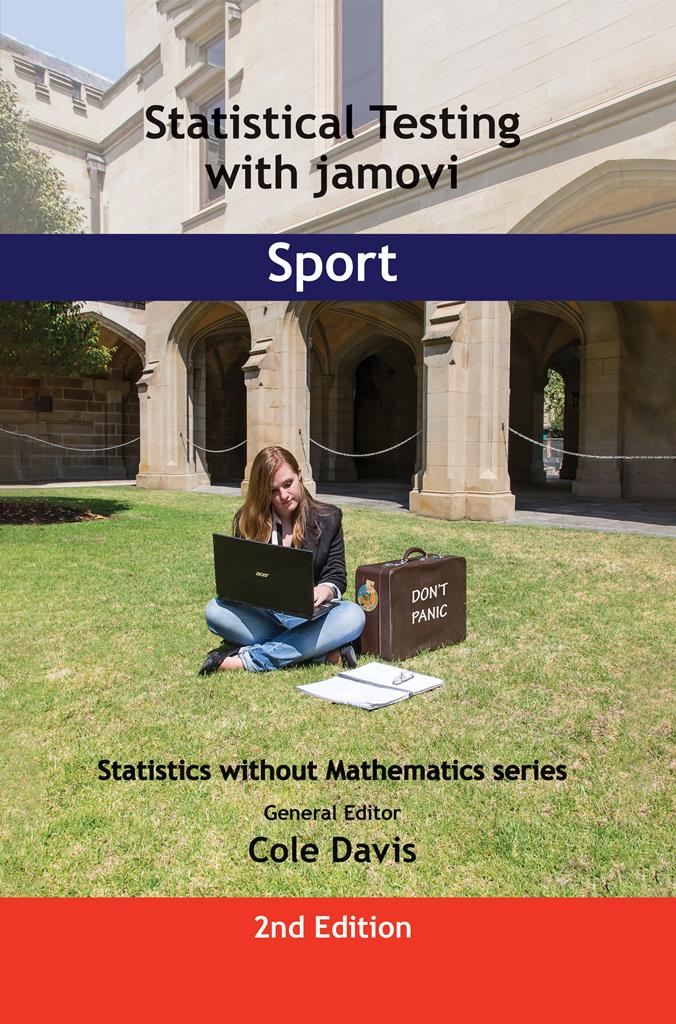|
| Home |
| Order books |

|
Statistical Testing with jamovi for Sport
Statistical Testing with jamovi for Sport
Exercises and case studies
Chapter 8 in the book contains basic exercises covering all of Section 2. Diverse tutors, however, have asked for traditional chapter by chapter exercises, hence the table immediately below. Further down the page, case studies are presented for readers who have finished reading the whole book, or their tutors.Exercises
These chapter by chapter exercises have been contributed by Marianne Vitug. For each chapter is a document with the questions, and one with the answers, with relevant spreadsheet files (with the .csv suffix). Each page opens in a new tab of your browser.
| Ch 2 Research design | Questions | Answer | self-entry |
| Ch 3 Descriptive statistics | Questions | Answers | data file 0 |
| Ch 4 Null hypothesis significance testing | Questions | Answers | data file 0 |
| Ch 5 Tests of differences | Questions | Answers | data file 1 |
| Ch 5 Tests of differences | data file 2 | ||
| Ch 5 Tests of differences | data file 3 | ||
| Ch 5 Tests of differences | data file 4 | ||
| Ch 6 Tests of relationships | Questions | Answers | data file |
| Ch 7 Categorical analyses | Questions | Answers | data file |
| Ch 10 Factorial ANOVA | Questions | Answers | data file 1 |
| Ch 10 Factorial ANOVA | data file 2 | ||
| Ch 10 Factorial ANOVA | data file 3 | ||
| Ch 11 ANCOVA | Questions | Answers | data file |
| Ch 12 MANOVA | Questions | Answers | data file |
| Ch 13 PCA and factor analysis | Questions | Answers | data file 1 |
| Ch 13 PCA and factor analysis | data file 2 | ||
| Ch 14 Logistic regression | Questions | Answers | data file |
| Ch 15 Partial correlations | Questions | Answers | data file |
| Ch 17 Bayesian statistics | Questions | Answers | data file |
| Ch 18 Survival analysis (Kaplan-Meier) | Questions | Answers | data file |
| Ch 19 Cluster analysis | Questions | Answers | data file |
Case studies
You have a selection of different measures derived from studies of foul play. Are there different categories of offender attitudes to contravention?
Looking at a battery of results from different measures of athletic performance, you wish to see if a particular model is especially robust.
You have a wealth of quantitative data on attitudes to performance-enhancing drugs. You believe that they have a substantial impact on locker room culture, personal instability and attitudes to sports authorities.
Is a particular type of sport rehabilitation likely to differ in its effectiveness depending on different types of accompanying psychological problem? For example, if graded activity were to be used rather than manual therapy, would it have very different effects on people whose accompanying symptoms were alcoholism, gambling addiction and depression? Age, ethnicity and gender may affect the classification.
You are interested in the willingness of students to participate in sports. Which psychological attributes tend to be associated with keen, apathetic and hostile attitudes? You may wish to consider attributes such as the number of fellow students with similar attitudes, the age and gender of the respondents.
What characteristics typify different levels of coaching success? Include gender and other demographic data as well as measurable attributes.
You are interested in how long it takes footballers to recover from severe sprains. Are there differences between age groups, or ethnicity, or attitudes to problems, or whether or not players have been taking performance-enhancing drugs?
Are schoolchildren in ability groupings more likely to develop sporting skills better than those in mixed ability groupings. Does gender have a part to play?
Each year, over three years, a different coaching approach is used with groups of students with learning disabilities. Each method is used within three different sports (no individual student is a participant in more than one of these sports). By the end of the period, each group of students would have experienced all of the methods.
Coaches try out three different coaching methods for improving the swimming techniques of students. Which works best, and are the differences dependent on coaches' personal attributes? (Or, perhaps, the swimmers' attributes.)
Are there particular types of athlete who are more likely to succumb to the temptations of doping?
(Assume no knowledge of the topic.)
Statistics without Mathematics series - General Editor: Cole Davis
ISBN numbers: Hardback - 978-1-915500-21-2 Paperback - 978-1-915500-22-9 Ebook - 978-1-915500-23-6
